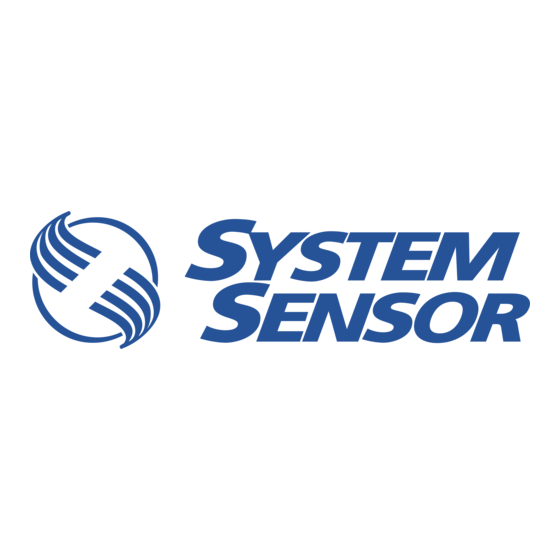
Advertisement
Quick Links
MOD400R
Field Sensitivity
Test Module
The MOD400R fulfills the NFPA 72 requirement for
detector sensitivity testing.
Features
• Compatible with all System Sensor direct wire and plug-in smoke
detectors (100, 200, 300, 400, and 500 Series), or System Sensor
DH100, DH200, DH400, and DH500 Series duct smoke detectors,
ionization or photoelectronic
• Fulfills NFPA 72 requirement for field sensitivity testing
• Interfaces with standard DC voltmeter or multimeter
• Low battery diagnostic: when connected to a voltmeter, the
MOD400R monitors its own battery voltage
• Quickly tests sensitivity of detectors without putting system into
alarm
Agency Listings
S2522
OX5A4.AY
The MOD400R Field Sensitivity Test Module is designed to
check the sensitivity of System Sensor 100, 200, 300, 400, and 500
Series conventional detectors or System Sensor DH100, DH200,
DH400, and DH500 series duct smoke detectors. The test module can
be connected to any DC voltmeter (meter movement of 10K ohms/v
or greater) to obtain a reading which correlates to the detector's
sensitivity range.
Advertisement

Summary of Contents for System Sensor MOD400R
- Page 1 MOD400R Field Sensitivity Test Module The MOD400R fulfills the NFPA 72 requirement for detector sensitivity testing. Features The MOD400R Field Sensitivity Test Module is designed to check the sensitivity of System Sensor 100, 200, 300, 400, and 500 • Compatible with all System Sensor direct wire and plug-in smoke Series conventional detectors or System Sensor DH100, DH200, detectors (100, 200, 300, 400, and 500 Series), or System Sensor DH400, and DH500 series duct smoke detectors. The test module can DH100, DH200, DH400, and DH500 Series duct smoke detectors, be connected to any DC voltmeter (meter movement of 10K ohms/v ionization or photoelectronic or greater) to obtain a reading which correlates to the detector’s • Fulfills NFPA 72 requirement for field sensitivity testing sensitivity range. • Interfaces with standard DC voltmeter or multimeter • Low battery diagnostic: when connected to a voltmeter, the MOD400R monitors its own battery voltage • Quickly tests sensitivity of detectors without putting system into alarm Agency Listings S2522 OX5A4.AY...
- Page 2 MOD400R Specifications Physical/Operating Specifications Dimensions 4½˝ × 31⁄8˝ × 1½˝ (11.43 cm × 7.93 cm × 3.81 cm) Shipping Weight 8.4 oz (238 gm) Test Capability System Sensor 100, 200, 300, 400, 500 Series Detectors System Sensor DH100, DH200, DH400, DH500 series duct smoke detectors Battery 9 V alkaline (1 year life) Testing and Maintenance Nuisance alarms from smoke detectors can be caused by a number of conditions, but one of the more prevalent is lack of proper maintenance. Everyday dust, grime, and moisture can render detectors ineffective or change sensitivity levels. Ease of Maintenance NFPA 72 requires that all smoke detectors shall be visually inspected in place at least semiannually to identify missing detectors, detectors with impeded smoke entry, abnormally dirty detectors, and detectors no longer suitably located because of occupancy or structural changes. The standard also goes on to say that a test shall be performed annually to assure that each smoke detector is operative and produces the intended response. System Sensor detectors have been designed with these requirements in mind. Detectors may be disassembled quickly to allow convenient access to the special .020˝ (0.5mm) mesh insect screen and chamber. The screen should be removed and thoroughly cleaned with a soft brush or vacuum to remove all loose and excessive dirt buildup. Clean compressed air is recommended to blow out any remaining debris on the screen or in the sensing chamber. Simple Testing Once cleaned, the detectors must be reinstalled and tested to insure proper operation of the system. All direct-wire detectors are equipped with a recessed switch that can be activated using any 0.1˝ maximum diameter object. When the switch is activated, the LED on the detector should light within 20 seconds to indicate alarm status. Plug-in detectors (with separate base) incorporate the use of a magnet test. The 400 Series photo can also be tested with a calibrated test card. A special slot in the screen housing allows the test card to be inserted into the chamber. The LED should indicate a latched alarm condition after 20 seconds when the ALARM end of the card is used; no reaction should occur when tested with the NO ALARM end. These built-in test functions are designed to simulate a 3% per foot obscuration level on the ionization units and a 4% per foot obscuration on the photoelectronic units. This is more than sufficient to determine if the detector will alarm, but is not an adequate way to test and...





Need help?
Do you have a question about the MOD400R and is the answer not in the manual?
Questions and answers